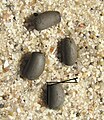Brasidas (genus)
| Brasidas | ||||||||||||
|---|---|---|---|---|---|---|---|---|---|---|---|---|

Brasidas foveolatus , |
||||||||||||
| Systematics | ||||||||||||
|
||||||||||||
| Scientific name | ||||||||||||
| Brasidas | ||||||||||||
| Rehn, JAG & Rehn, JWH , 1939 |


The genus Brasidas is a genus of ghosts native to the Philippines , which was named after the Spartan general Brasidas .
features
The representatives of this genus correspond in habit to typical representatives of the Obrimini and thus very similar in appearance to Sungaya inexpectata or the Trachyaretaon species such as the well-known Trachyaretaon carmelae . A pair of very noticeable holes or pits in the metasternum is characteristic of this genus . Similar indentations can otherwise only be found in the representatives of the genus Euobrimus . The males of the previously known species are about 55 to 65 millimeters in length, much smaller than the approximately 80 to 95 millimeters long females. In egg-laying adult females, the middle of the abdomen is clearly thickened in height and width. The laying spine at the end of the abdomen surrounds the actual ovipositor . It is formed ventrally from the eighth sternite , here called the subgenital plate or operculum , and dorsally from the eleventh tergum , which is here called the supraanal plate or epiproct .
Way of life and reproduction
The eggs are laid in the ground by the females with the laying stinger. Typical of the eggs, which are usually four to five millimeters long and two to three millimeters wide, is the bulging, protruding dorsal area and the cover ( operculum ) sloping down towards the ventral side . Because of this construction, Brasidas eggs have a clearly recognizable opercular angle (see also construction of the phasmid egg ).
Systematics
In 1939, James Abram Garfield Rehn and John WH Rehn published an extensive work in which, among other things, they established the genus Brasidas . In this they put two already known species, which until then were counted to the genus Obrimus . They also described four new Brasidas species and a new subspecies. The newly described species Brasidas samarensis was established as the type species . Brasidas acanthoderus was described using a female nymph .
The types described so far are:
- Brasidas acanthoderus Rehn, JAG & Rehn, JWH , 1939
- Brasidas foveolatus ( Redtenbacher , 1906)
- Brasidas montivagus Rehn, JAG & Rehn, JWH , 1939
- Brasidas quadratipes ( Bolívar , 1890)
- Brasidas samarensis Rehn, JAG & Rehn, JWH , 1939
- Brasidas viscayanus Rehn, JAG & Rehn, JWH , 1939
In October 2011, the accumulated Philippines living Frenchman Thierry Heitzmann on the island of Rapu-Rapu four couples of another kind. The very large animals have not yet been determined or described and according to their location as Brasidas sp. 'Rapu-Rapu'.
Francis Seow-Choen and Ian Abercrombie found another, undefined and probably undescribed species of the genus in October 2012 near Valencia City in the province of Bukidnon on the island of Mindanao . After its place of discovery it is called Brasidas sp. 'Bukidnon'.
Terrariums
The genus is present in the terrariums of lovers through several representatives . The first species introduced in 2002 was Brasidas samarensis , which is managed by the Phasmid Study Group under PSG number 235. In 2008 Brasidas foveolatus was also imported and assigned the PSG number 301.
Later (around 2010), other animals were imported from the same site as Brasidas foveolatus , namely from Nabunturan on the island of Mindanao . They were first named Brasidas sp. 'Nabunturan'. It has not yet been investigated whether these animals are representatives of a different species. The animals that Heitzmann collected on Rapu-Rapu have also reached Europe. After three of the four collected pairs died, the fourth female laid enough eggs to be able to send some to Europe. In 2012, the Swiss Philipp Heller succeeded in hatching some animals from these, raising them successfully and passing them on.
photos
credentials
- ^ A b Paul D. Brock : Phasmida Species File Online . Version 2.1 / 4.0. (accessed on June 30, 2010)
- ↑ Ingo Fritzsche : Poles - Carausius, Sipyloidea & Co. , Natur und Tier Verlag, Münster 2007, ISBN 978-3-937285-84-9
- ↑ Christoph Seiler, Sven Bradler, Rainer Koch: Phasmids - care and breeding of ghost horrors, stick insects and walking leaves in the terrarium . bede, Ruhmannsfelden 2000, ISBN 3-933646-89-8
- ↑ a b c J.AG Rehn & JWH Rehn: Proceedings of The Academy of Natural Sciences (Vol. 90, 1938) , Philadelphia 1939, p. 435 ff. ( File version )
- ^ A b Thierry Heitzmann phasmid page with report on Brasidas sp. 'Rapu-Rapu'
- ↑ Thierry Heitzmann phasmid page with report on Brasidas sp. "Bukidnon"
- ↑ Phasmid page by Frank H. Hennemann & Oskar V. Conle ( Memento of the original from May 2, 2011 in the Internet Archive ) Info: The archive link has been inserted automatically and has not yet been checked. Please check the original and archive link according to the instructions and then remove this notice.
- ↑ Phasmid Study Group Culture List ( Memento from December 5, 2012 in the web archive archive.today ) (English)
- ↑ Pictures of Brasidas sp. 'Nabunturan' on Phasma.eu (Dutch-Belgian) ( Memento of the original from July 2, 2012 in the Internet Archive ) Info: The archive link has been inserted automatically and has not yet been checked. Please check the original and archive link according to the instructions and then remove this notice.




